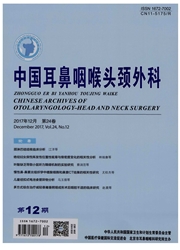

 中文摘要:
中文摘要:
目的 探讨头-眼运动训练视频在前庭功能减退患者前庭康复中的作用及效果。方法 对2015年8月~2016年8月在耳鼻咽喉科就诊并确诊为前庭功能障碍37例行前庭康复训练,内容包括:采用视频软件进行头动训练和头-眼运动协调性训练;同时进行静态平衡功能练习和动态平衡功能练习,分别于训练前和训练2周后进行眩晕残障量表(dizziness handicap inventory,DHI)、眩晕的视觉模拟评分(visual analogue scale,VAS)和Romberg试验计时,并进行分析比较。结果 训练后DHI评分和眩晕VAS评分较训练前均显著降低(P〈0.01);训练后Romberg试验计时较训练前显著延长(P〈0.01)。结论 头-眼运动训练视频可用于前庭康复训练,效果良好,值得临床推广。
 英文摘要:
英文摘要:
OBJECTIVE To study the effect of the video of head-eye movement training in vestibular rehabilitation. METHODS 37 patients aged between 30 and 76 years old with vestibular dysfunction underwent two weeks of rehabilitation with the video of head-eye movement training. The results of dizziness handicap inventory (DHI), dizziness analogue scale, and the Romberg static balance tests were recorded before and after the rehabilitation. RESULTS After the rehabilitation, there was significant decrease in the scores of DHI and dizziness analog scale(all P〉0.001), and there was significant improvement in the time of Romberg static balance tests(P〉 0.001). CONCLUSION The video of head-eye movement training is an effective method in vestibular rehabilitation.
 同期刊论文项目
同期刊论文项目
 同项目期刊论文
同项目期刊论文
 期刊信息
期刊信息
